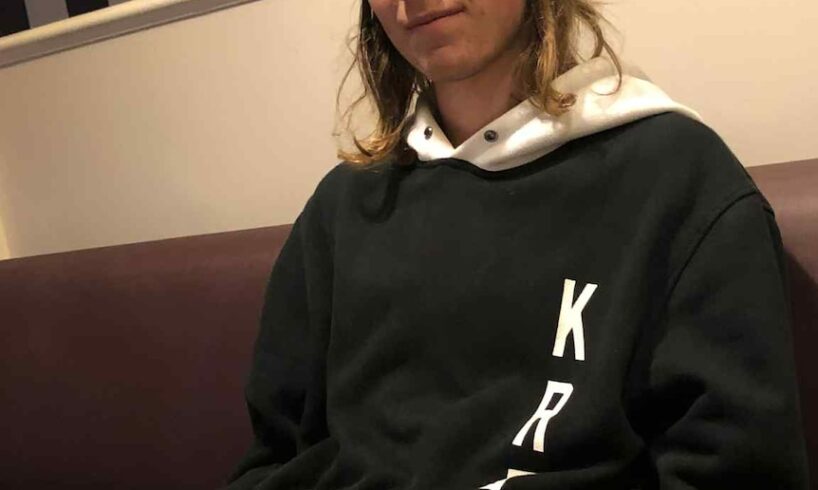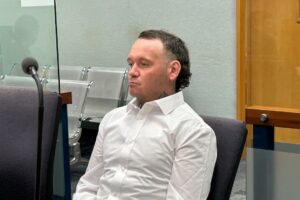
A jury has begun deliberating in the trial of three people accused of kidnapping, murdering and burning the body of a 19-year-old in northern Victoria in December 2022.
The remains of Charlie Gander’s body were found in a burnt-out car at Bunbartha on Christmas Eve, 2022.
Kylie Stott, Dimitri D’Elio and Danny Clarke have pleaded not guilty to kidnapping, murder and arson in a trial painted by the prosecution as a desire for revenge against Charlie for “ratting out” their associate to the police.
The jury was shown photos taken by Victoria Police of the burnt car, which contained the remains of Charlie Gander’s body. (Supplied: Supreme Court of Victoria)
At the time of the alleged offending, Ms Stott was aged 37, Mr D’Elio 24 and Mr Clarke 38.
All three have pleaded not guilty.
The 12 jurors have begun deliberating after 30 days of hearings, including about 41 witnesses made up of pathologists, DNA experts, emergency services and police officers.
The jury also heard statements read out by the prosecutor from Mr Gander’s girlfriend and his father Richard Gander, including final texts between the pair.
Police evidence cost teenager ‘dearly’, says Crown
In his final address, Mr Gibson argued that each of the accused was guilty of the three charges “because each of them was part of an agreement, arrangement or understanding with the others to kidnap Charlie Gander, to murder Charlie Gander and to burn the Ford Territory with Charlie Gander’s body in it”.
Mr Gibson told the jury the alleged motive was Mr Gander’s cooperation with police investigating a firearms breach by Tyson May, who was a good friend of Ms Stott.
Mr Gander was also friends with Mr May and would hang out with him, the court heard.
Following a police raid in Shepparton in November 2022, Mr Gander gave a police interview and made a witness statement about Mr May possessing a firearm.
The court heard Gander’s body contained high levels of ice, which could not be ruled out as a cause of death. (Supplied: Gander family)
Mr May was under a firearms prohibition order, Mr Gibson said.
A disc with the record of Mr Gander’s police interview “found its way into the hands of others”, Mr Gibson said.
“It cost him dearly,” he said.
The court heard a kitchen knife wrapped in a bloodstained tea towel from under a car seat had a mixed DNA profile of four people, including Mr Gander.
Forensic pathologist Paul Bedford, who conducted Mr Gander’s autopsy, previously told the court extensive fire damage to the body meant the cause of death could not be ascertained.
He also told the court toxicology reports had found very high levels of the drug methylamphetamine, commonly known as ice, which may have contributed to Mr Gander’s death.
Defence arguments
Justice Michael Croucher presented a summary of the defence counsel’s arguments to the court before the jury began deliberating.
Daniel Sala, acting for Ms Stott, has rejected the prosecution’s arguments that she was key in orchestrating the acts against Mr Gander and urged the jury to find her not guilty of murder or arson.
Paul Kounnas, acting on behalf of Mr D’Elio, has argued Ms Stott and Mr Clarke were the “prime movers” in the alleged crimes and that Mr D’Elio was “dragged along” and used as a “patsy”.
Emergency services found the car on fire on a dirt road in Bunbartha in Victoria’s north. (Supplied: Supreme Court of Victoria)
The court heard Mr D’Elio, who was in a relationship with Ms Stott, did not know Mr Gander or Mr Clarke and had “no skin in the game”.
Christopher Terry, acting on behalf of Mr Clarke, has argued his client did not intend to kill Mr Gander or enter into any agreement to do so.
He said there was no evidence of Mr Clarke’s hatred towards Mr Gander or proof of an agreement, and that his client had been “dragged into a terrible crime”.
Charges heard together
Justice Croucher instructed the jury that they must reach a unanimous verdict for each of the accused, who each face three charges.
The jury heard they may find the accused guilty of manslaughter as an alternative if they are not satisfied beyond reasonable doubt of the higher charge of murder.
Justice Croucher told the jury manslaughter did not require an intent to kill, but there must be an intentional assault that was dangerous and posed serious injury.
He also told the jury their task did not include making moral judgements.
He noted jurors had been tasked with not one trial but 12 separate decisions, with the three accused facing three charges and the potential for manslaughter.
The 12 charges are being heard together for convenience, and the jury must “not allow this fact to usurp justice” and must consider each charge separately, Justice Croucher said.





